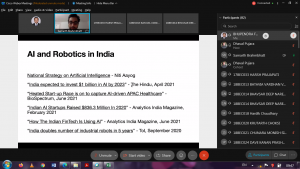 The Department of Electronics and Communication Engineering organised a lecture series on ?Computer Vision, Machine Learning and Robotics?. The entire lecture series was planned for the BTech students of the ECE department. Dr Samarth Brahmbhatt, Post-Doc in the Intel Intelligent Systems Lab, USA, and alumnus of Nirma University conducted six sessions on the given topic during June-July 2021. The detailed schedule of these sessions is as follows:
The Department of Electronics and Communication Engineering organised a lecture series on ?Computer Vision, Machine Learning and Robotics?. The entire lecture series was planned for the BTech students of the ECE department. Dr Samarth Brahmbhatt, Post-Doc in the Intel Intelligent Systems Lab, USA, and alumnus of Nirma University conducted six sessions on the given topic during June-July 2021. The detailed schedule of these sessions is as follows:
| Date | Day | Time |
| 20/06/2021 | Sunday | 9:30 – 11:00 am |
| 27/06/2021 | Sunday | 9:30 – 11:00 am |
| 04/07/2021 | Sunday | 9:30 – 11:00 am |
| 11/07/2021 | Sunday | 9:30 – 11:00 am |
| 18/07/2021 | Sunday | 9:30 – 11:00 am |
| 25/07/2021 | Sunday | 9:30 – 11:00 am |
In the first lecture, Dr Samarth discussed the introduction of Computer Vision and the plan of the lecture series. Then he discussed various real-time applications of Computer Vision. He shared his experiences with the students and encouraged them to study Computer Vision, Machine Learning, and Robotics as these topics are very relevant for today?s age of technology.
The concept of Geometry Transformation and Image Formation was discussed in the second session. Dr Samarth discussed 2D and 3D transformation with examples. He also showed the relationship between Cartesian and homogeneous coordinates. Further, he introduced the Pin-Hole Camera model for Image Formation and derived the projection equation for 3D point to 2D point. At the end of the session, he explained the homework to the students using google colab. He created a website to share the homework, lecture pdfs, and notes on the CV-ML-Lecture series.
At the beginning of the third session, the expert, Dr Samarth summarized previous session topics and homework. Next he discussed Single- and Multi-View Geometry and Intrinsic and Extrinsic parameters of the camera. In addition, he demonstrated a special case where images of a planar scene are related by homography. Towards the end, he derived the Direct Linear Transform (DLT) algorithm for homography estimation from 2D-2D correspondences.
The fourth session was continued on Single- and Multi-View Geometry. First, the necessity of camera calibration for CV applications was demonstrated and then discussed the camera calibration method from a hypothetical case of known 2D-3D correspondences and the need for a chessboard in camera calibration. Further, an overview of Triangulation, epipolar line, and stereo matching overview, and object pose estimation was discussed. In addition, the inverse warping for transferring content between images was elaborated. At the end of the session, the solutions to the homework were discussed and shared on the website.
The first four sessions included fundamentals of Computer Vision. The fifth session had a brief overview of Machine Learning. In this session, the basics of supervised learning, loss functions, gradient descent, Support Vector Machine, and Neural Networks were elaborated. Next, feature extraction from 2D convolution was demonstrated. In the end, the importance of backpropagation and differentiable computation graphs in machine learning was discussed.
The final session was allocated for Robotics. In this session, the state and control input of a robot was elaborated through a case study on state equations for a non-holonomic wheeled robot. The remaining part of the session covered key aspects of robotics such as robot arm kinematics, kinematic chain, and PID control.
Students actively participated in all the sessions and the various queries related to CV, ML and Robotics were responded to by Dr. Samarth Brahmbhatt.
This lecture series ended with a vote of thanks. The students’ feedback was overwhelming and they insisted on conducting such sessions in the future.